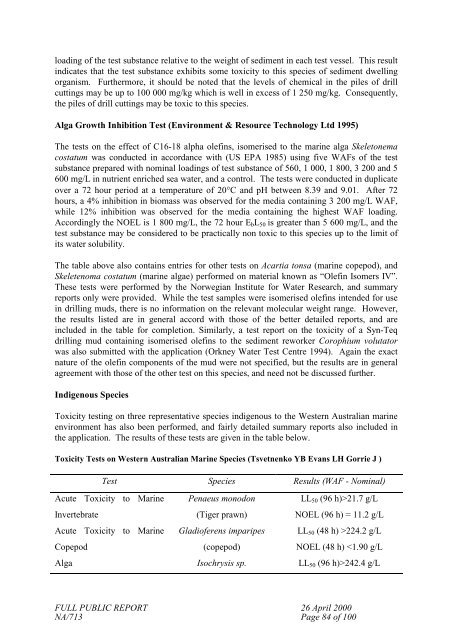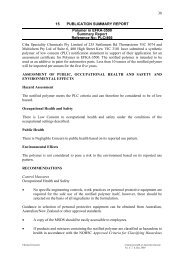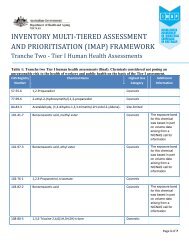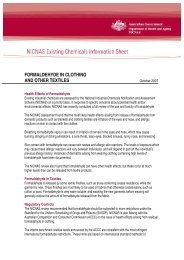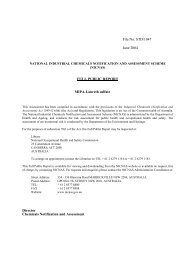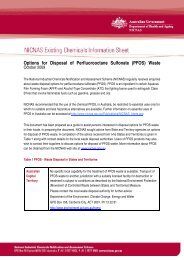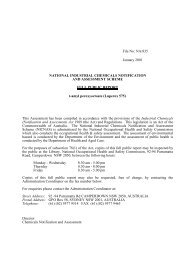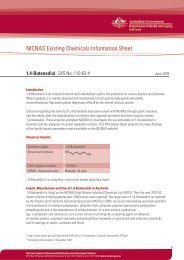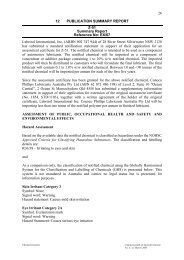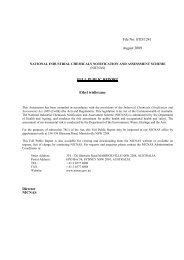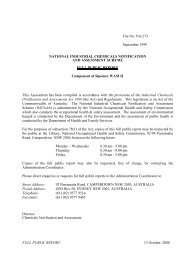GULFTENE C16-18 ISOMERISED OLEFINS - NICNAS
GULFTENE C16-18 ISOMERISED OLEFINS - NICNAS
GULFTENE C16-18 ISOMERISED OLEFINS - NICNAS
You also want an ePaper? Increase the reach of your titles
YUMPU automatically turns print PDFs into web optimized ePapers that Google loves.
loading of the test substance relative to the weight of sediment in each test vessel. This result<br />
indicates that the test substance exhibits some toxicity to this species of sediment dwelling<br />
organism. Furthermore, it should be noted that the levels of chemical in the piles of drill<br />
cuttings may be up to 100 000 mg/kg which is well in excess of 1 250 mg/kg. Consequently,<br />
the piles of drill cuttings may be toxic to this species.<br />
Alga Growth Inhibition Test (Environment & Resource Technology Ltd 1995)<br />
The tests on the effect of <strong>C16</strong>-<strong>18</strong> alpha olefins, isomerised to the marine alga Skeletonema<br />
costatum was conducted in accordance with (US EPA 1985) using five WAFs of the test<br />
substance prepared with nominal loadings of test substance of 560, 1 000, 1 800, 3 200 and 5<br />
600 mg/L in nutrient enriched sea water, and a control. The tests were conducted in duplicate<br />
over a 72 hour period at a temperature of 20°C and pH between 8.39 and 9.01. After 72<br />
hours, a 4% inhibition in biomass was observed for the media containing 3 200 mg/L WAF,<br />
while 12% inhibition was observed for the media containing the highest WAF loading.<br />
Accordingly the NOEL is 1 800 mg/L, the 72 hour EbL50 is greater than 5 600 mg/L, and the<br />
test substance may be considered to be practically non toxic to this species up to the limit of<br />
its water solubility.<br />
The table above also contains entries for other tests on Acartia tonsa (marine copepod), and<br />
Skeletenoma costatum (marine algae) performed on material known as “Olefin Isomers IV”.<br />
These tests were performed by the Norwegian Institute for Water Research, and summary<br />
reports only were provided. While the test samples were isomerised olefins intended for use<br />
in drilling muds, there is no information on the relevant molecular weight range. However,<br />
the results listed are in general accord with those of the better detailed reports, and are<br />
included in the table for completion. Similarly, a test report on the toxicity of a Syn-Teq<br />
drilling mud containing isomerised olefins to the sediment reworker Corophium volutator<br />
was also submitted with the application (Orkney Water Test Centre 1994). Again the exact<br />
nature of the olefin components of the mud were not specified, but the results are in general<br />
agreement with those of the other test on this species, and need not be discussed further.<br />
Indigenous Species<br />
Toxicity testing on three representative species indigenous to the Western Australian marine<br />
environment has also been performed, and fairly detailed summary reports also included in<br />
the application. The results of these tests are given in the table below.<br />
Toxicity Tests on Western Australian Marine Species (Tsvetnenko YB Evans LH Gorrie J )<br />
Test Species Results (WAF - Nominal)<br />
Acute Toxicity to Marine<br />
Invertebrate<br />
Acute Toxicity to Marine<br />
Copepod<br />
Penaeus monodon<br />
(Tiger prawn)<br />
Gladioferens imparipes<br />
(copepod)<br />
LL50 (96 h)>21.7 g/L<br />
NOEL (96 h) = 11.2 g/L<br />
LL50 (48 h) >224.2 g/L<br />
NOEL (48 h) 242.4 g/L<br />
FULL PUBLIC REPORT 26 April 2000<br />
NA/713 Page 84 of 100


